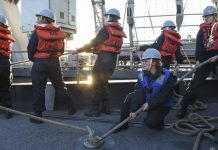How to tackle bullying and harassment onboard. Companies and the management must be receptive for change. Adoption of the zero-tolerance approach will be appreciative.
The Crew Health Programme Director, UK club, Sophia Bullard, shares her valuable comments over how to tackle bullying and harassment onboard. Companies and the management must be receptive for change. Adoption of the zero-tolerance approach will be appreciative.
Since a decade, there is a raise on the focus relating to harassment in maritime. Campaigns are conducted to increase awareness, promote fair practices and implement guidelines to deal with the issue. These are all constructive steps, Sophia Bullard says, but she adds that bullying persists to be a challenging issue for the seafarers.
Seafarers are often seen as ‘tough people’ in the field, but this can be a rather partial perception. Working at sea can make seafarers more sensitive to harassment and bullying. The usual working conditions, the seclusion, the tough nature of the profession and the anxiety of further deception or repercussions or bullying is reported, as martyr may be labelled as troublemakers or may have their contracts terminated.
As harassment and bullying in the workplace have raised, the Maritime Labour Convention (MLC) recognized the adverse effect that this situation may have on seafarer’s physical health and mental wellness. This has bought reasons that it voted to bring this critical matter under Regulation 4.3 – the health and safety protection and accident protection code.
Demonstrating the definition of harassment, Ms. Bullard outlines that it involves any improper and undesirable conduct, which, either intentionally or unintentionally, may build a feeling of unease, humiliation, embarrassment or discomfort for the receiver.
When bullying is talked upon, it is a type of harassment that involves hostile or revengeful behavior, whose conclusion may make the recipient feel threatened or frightened.
In order to revive this situation, companies and management must be the prime active agents of change, by carrying out a zero-tolerance approach to deal with bullying and harassment at sea.
This can be attended with the following steps:
- Layout fair policies and procedures for dealing with harassment and bullying onboard;
- Communicate the company’s policies relating harassment to everybody onboard (in the innate language of crew members);
- Organize awareness programs, training sessions, campaigns, videos, conferences, and other media;
- Build channels of reporting and actions to be taken when a grievance is filed;
- Ensure solitude and confidentiality to boost disclosure;
- Establish fair job roles, expectations and responsibilities;
- Manage time in ongoing training;
- Apply clear and transparent processes for assigning tasks, job roles, etc.;
- Educate all crew for early warning signs, such as when a seafarer looks sad, lonely, scared, confined, not motivated, low performance, complains of physical symptoms, avoids social interactions, etc.;
- Implement emotional intelligence plans to encourage self-awareness, social awareness, and conflict resolution;
- Organizing team building sessions, inspirational leadership training, and cultural diversity working groups;
- Organizing activities to develop social interactions onboard.
Bullying and harassment are essential issues in any workplace environment, and this is specifically true at sea due to the cultural diversity of crew members and the different pressures that they are exposed to. Expanding people’s knowledge around the topic can automatically decline the incidents of bullying and harassment.
































